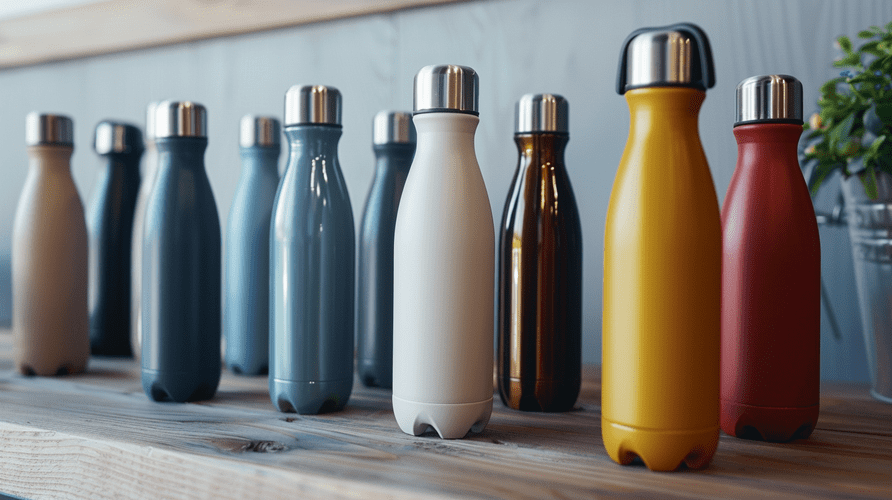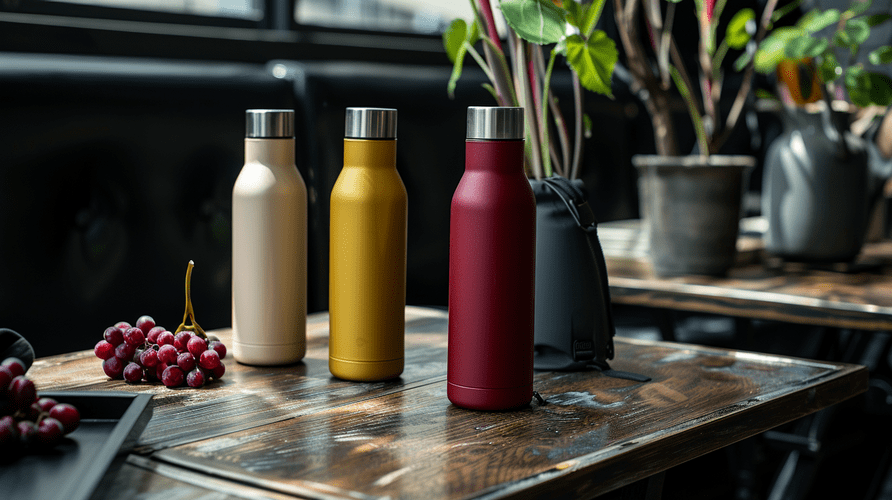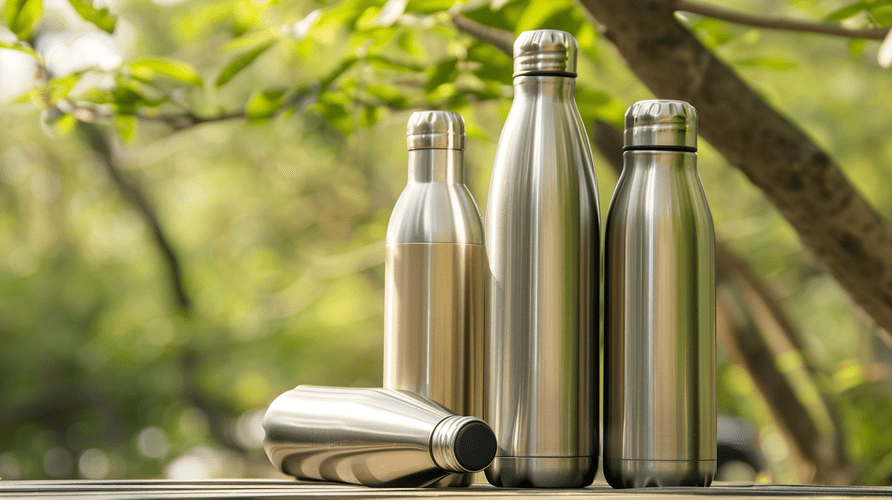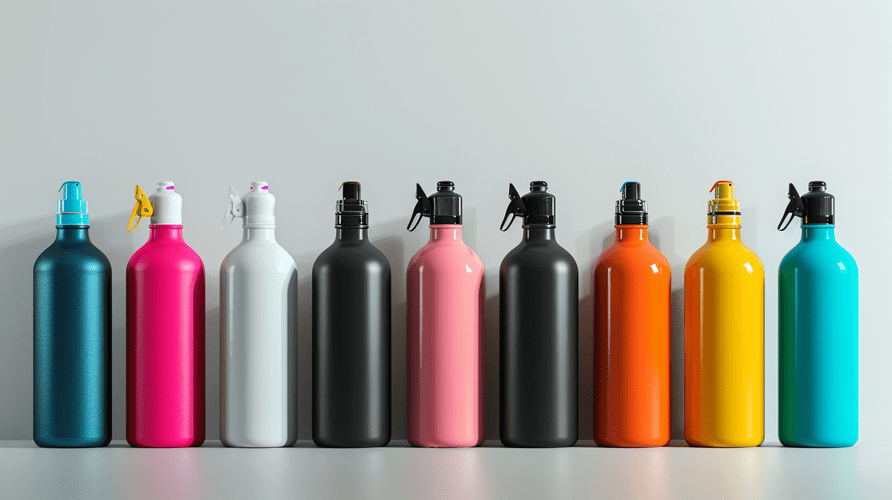Struggling with steel choices? Unsure which grade suits your products best? Get clarity now.
304 stainless steel offers superior corrosion resistance due to its higher nickel content. 201 stainless steel is a lower-cost alternative with less nickel, making it more prone to rust over time, especially with acidic contents.

Choosing the right stainless steel is vital for product quality and customer satisfaction. As Aries Hua from Icobottle, I've seen how it affects durability, safety, and even taste for products like hip flasks and water bottles. Let's explore these differences further so you, whether a procurement officer or a startup boss, can make informed decisions for your business.
What is the difference between stainless 304 and 202?
Confused by stainless steel numbers? Wondering if 202 is a good fit for your needs? Let's clarify.
304 stainless steel has more nickel, offering better rust protection than 202. 202 uses manganese and nitrogen to reduce cost. This also reduces its defense against corrosion, especially for beverage containers.

When I first started in this business, understanding the nuances between different stainless steel grades1 like 304 and 202 was a steep learning curve. My client, Mark Shenng from Canada, is very particular about quality for his stainless steel water bottles. He’s 54 and an assertive company owner, so he knows his customers expect a premium product. This means the steel must not only look good but also perform exceptionally over time. It must resist rust and any potential leaching. For him, and for many of my B2B clients, the choice of material is a direct reflection of their brand's promise. The key difference lies in their composition. This affects their performance, especially in demanding applications like water bottles or coffee mugs we produce at Icobottle.
Composition and Cost Implications
The main distinction between 304 and 202 stainless steel is their chemical makeup. This directly impacts their properties and cost. Mark, being sensitive to quality but also seeking competitive pricing, always weighs these factors.
| Feature | 304 Stainless Steel | 202 Stainless Steel |
|---|---|---|
| Nickel (Ni) | ~8-10.5% | Lower than 304 (e.g., ~4-6%) |
| Chromium (Cr) | ~18-20% | Similar to 304 (~17-19%) |
| Manganese (Mn) | Max 2% | Higher than 304 (e.g., ~7.5-10%) |
| Nitrogen (N) | Max 0.1% | Higher than 304 (e.g., up to 0.25%) |
| Cost | Higher | Lower |
304 stainless steel2, often called 18/8, contains about 18% chromium and 8% nickel. The nickel is crucial for its excellent corrosion resistance. 202 stainless steel is part of the 200 series. These were developed to reduce costs. They use more manganese and nitrogen as partial substitutes for nickel. This makes 202 more economical. However, it compromises its ability to fight off rust and corrosion as effectively as 304. This is a critical point for Mark. He purchases stainless steel water bottles from foreign suppliers like us in China for his distribution business in Canada. He needs reliable materials.
Corrosion Resistance and Applications
For products like the hip flasks, water bottles, coffee mugs, and tumblers we export to America and Europe, corrosion resistance is most important. 304 stainless steel excels here. It is highly resistant to various corrosive agents. This includes acidic beverages. This non-reactivity also means it will not impart any metallic taste. This ensures the purity of the contents.
202 stainless steel has lower nickel and higher manganese content. This makes it less resistant to corrosion. It might be suitable for some general kitchen items where cost is a primary driver. And where the environment is not overly corrosive. But it is generally not the preferred choice for high-quality beverage containers. The risk of rust or staining is higher. This is especially true if the product is expected to last a long time or handle diverse liquids. As a B2B supplier focusing on top-quality with customized logos and colors, I always emphasize to clients like Mark that opting for 304 for beverage products means fewer complaints. It also means a better brand image. For procurement officers in large companies or startup owners, this translates to long-term value and reliability. Mark understands sales but lacks deep technical expertise, so clear explanations like this are helpful.
Can a magnet stick to 201 stainless steel?
Wondering about magnetism in your steel? Does 201 stainless steel react to magnets? Let's find out.
Yes, a magnet can often stick to 201 stainless steel. This is especially true after the steel has been cold-worked, like when it's shaped into a bottle or mug.

I remember a conversation with Mark about this very topic. He was inspecting a batch of sample water bottles sourced from a developing country, possibly Vietnam or China. He noticed some were slightly magnetic. This sparked a discussion about the properties of 201 stainless steel. For his business, which focuses on rebranding and distributing premium water bottles, understanding every detail is important. Magnetism might not directly impact the bottle's primary function of holding water. But it's about complete product knowledge. This helps him address any concerns from his customers in Canada.
Austenitic Stainless Steel and Magnetism
Most stainless steels used for our products at Icobottle, like the 200 and 300 series (which include 201, 202, and 304), are "austenitic." In their fully annealed state, these steels are generally non-magnetic. This is because their crystal structure is not ferromagnetic.
However, things change with "cold working." Cold working includes processes like forming, bending, or drawing the steel at room temperature. We use these methods to shape it into the final product, such as a water bottle or a coffee mug.
| Steel Grade | Annealed State | Cold-Worked State | Primary Reason for Magnetism Change |
|---|---|---|---|
| 201 SS | Non-magnetic | Can become noticeably magnetic | Austenitic structure transforms to martensite. |
| 304 SS | Non-magnetic | Can become slightly magnetic | Austenitic structure can transform to martensite. |
When 201 stainless steel is cold-worked, its austenitic structure can partially transform into "martensite." Martensite is ferromagnetic. 201 stainless steel has more manganese and nitrogen and less nickel compared to 304. So, its austenitic form is less stable during cold working. This means it is more prone to this transformation. It is, therefore, more likely to become noticeably magnetic after manufacturing. This doesn't necessarily mean lower quality for all applications. But it is a distinct characteristic of 201 stainless steel. For Mark, who is focused on quality inspection and avoiding certificate fraud by suppliers, understanding these material properties is key.
Why Does This Matter for Water Bottles?
For a water bottle, being magnetic usually does not affect its performance. It does not change its ability to hold water or its corrosion resistance. (Though the composition that makes it magnetic does affect corrosion resistance.) However, some consumers might mistakenly think magnetism means lower quality or "not real" stainless steel. This is a misconception. As I explained to Mark, the magnetism in 201 is a result of its composition and processing. 304 can also become slightly magnetic after severe cold working. But this is generally less pronounced than in 201. For his premium brand, Mark prefers 304. This helps minimize any such potential customer concerns. It also offers superior corrosion resistance.
Why is stainless steel 304 better?
Seeking the best material for your products? Is 304 stainless steel truly the superior choice? Let's delve in.
304 stainless steel is favored for its excellent rust resistance and food-grade safety3. This makes it highly durable and reliable for items like water bottles and mugs.

When I am advising clients, especially those new to sourcing stainless steel products, the question of "better" often comes up. Mark, with his experience as a company owner and procurement officer, already leans towards 304 for his water bottles. But he always appreciates a refresher on why it maintains its top-tier status. It is not just about a single feature. It is a combination of properties. These make 304 the industry standard for high-quality food and beverage contact items. For my business, Icobottle, providing top-quality products with customized logos and colors means starting with the best materials. This is crucial when exporting to demanding markets like America and Europe.
The Core Advantages of 304 Stainless Steel
Several key factors contribute to 304 stainless steel's reputation. It is seen as a superior material, particularly for products that touch consumables. These factors are vital for B2B buyers like procurement officers from large companies or startup bosses.
| Feature | 304 Stainless Steel Benefit | Implication for Products (e.g., Water Bottles) |
|---|---|---|
| Superior Corrosion Resistance | Higher nickel content (~8-10.5%) creates a strong passive layer. This protects against rust and stains. | Long product life. Maintains appearance. Suitable for various liquids, including acidic ones. |
| Food-Grade Safety | Globally recognized (18/8 or 18/10 steel). Safe for food and beverage contact. | Ensures no harmful leaching. Meets international safety standards like FDA, LFGB. |
| Durability & Maintainability | Resistant to oxidation. Easy to clean due to its smooth, non-porous surface. | Withstands frequent use and cleaning. Hygienic. Prevents bacteria buildup. |
| Non-Reactivity | Does not react with foodstuffs or beverages. | Preserves the original taste of contents. No metallic flavor is imparted. |
| Proven Track Record | Decades of use in kitchenware, medical devices, and food processing. | High level of trust and reliability among manufacturers and consumers. |
The higher nickel content in 304 is a game-changer. This element is crucial for forming a stable "passive layer" of chromium oxide on the steel's surface. This layer self-repairs. It provides excellent protection against various corrosive environments. This is why it is ideal for my products – water bottles, coffee mugs, tumblers, and cups. These are regularly exposed to liquids. Mark’s key focus during purchases includes quality inspection and certification. Using 304 consistently helps meet these requirements.
Why Not Just Opt for Cheaper Alternatives Like 201?
Grades like 201 are cheaper. This is due to lower nickel content (manganese and nitrogen are substituted). But this cost-saving comes at the expense of corrosion resistance4. For a startup boss or a procurement officer, the initial saving on 201 might seem attractive. However, potential issues like rust, staining, or even a metallic taste in beverages can occur. This can lead to customer dissatisfaction, returns, and damage to brand reputation. Mark faced this early in his career with a different supplier. This led to inefficient communication, delayed shipments, and missed peak sales seasons due to quality rejects. These are pain points he is keen to avoid. He knows that using 304 for his stainless steel water bottles is a better long-term investment. This is true even if it is slightly more expensive. It upholds the premium quality of his brand in Canada. When product quality is assured upfront, aspects like logistics and payment methods also become smoother. This ensures he can focus on his profit model of distributing rebranded goods effectively.
Conclusion
Choosing 304 stainless steel ensures superior rust resistance and food-grade safety. It's the ideal material for quality water bottles, protecting your brand and satisfying customers like Mark.
-
Discover the various stainless steel grades and their applications to better understand which is suitable for your needs. ↩
-
Explore this link to understand why 304 stainless steel is preferred for its corrosion resistance and durability, especially in premium products. ↩
-
Learn about food-grade safety standards to ensure your products meet health regulations and consumer expectations. ↩
-
Discover how corrosion resistance impacts product longevity and performance, crucial for quality manufacturing. ↩

